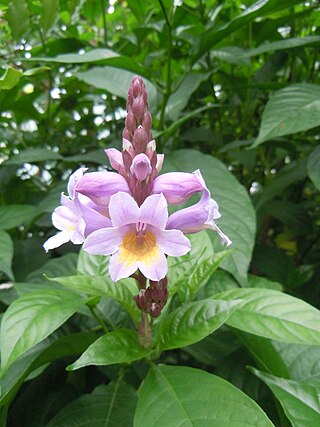
Acanthaceae is a family of dicotyledonous flowering plants containing almost 250 genera and about 2500 species. Most are tropical herbs, shrubs, or twining vines; some are epiphytes. Only a few species are distributed in temperate regions. The four main centres of distribution are Indonesia and Malaysia, Africa, Brazil, and Central America. Representatives of the family can be found in nearly every habitat, including dense or open forests, scrublands, wet fields and valleys, sea coast and marine areas, swamps, and mangrove forests.

Strobilanthes is a genus of about 350 species of flowering plants in the family Acanthaceae, mostly native to tropical Asia and Madagascar, but with a few species extending north into temperate regions of Asia. Many species are cultivated for their two-lipped, hooded flowers in shades of blue, pink, white and purple. Most are frost-tender and require protection in frost-prone areas. The genus is most famed for its many species which bloom on long cycles of several years, such as Strobilanthes wightii which blooms every thirteen years.

Justicia is a genus of flowering plants in the family Acanthaceae. It is the largest genus within the family, encompassing around 700 species with hundreds more as yet unresolved. They are native to tropical to warm temperate regions of the Americas, India, and Africa. The genus serves as host to many butterfly species, such as Anartia fatima. Common names include water-willow and shrimp plant, the latter from the inflorescences, which resemble a shrimp in some species. The generic name honours Scottish horticulturist James Justice (1698–1763). They are closely related to Pachystachys.

Dicliptera is a genus of flowering plants in the bear's breeches family, Acanthaceae. Well-known synonyms include Peristrophe and Dactylostegium.

Hypoestes is a flowering plant genus of about 150 species. They are widely distributed throughout the tropical and subtropical lands around the Indian Ocean, and some adjacent regions.

The genus Asystasia belongs to the family Acanthaceae and comprises approximately 70 species found in the tropics, including the weedy species Asystasia gangetica.
Anisotes is a genus of Afrotropical plants in the family Acanthaceae. The genus is morphologically similar to Metarungia, from which it differs mainly in the dehiscence of the fruit capsule, and the nature of the placenta. Placentas remain attached to the inner surface of fruit capsules in Anisotes.

Rhinacanthus is a genus of plants in the family Acanthaceae. It contains the following species :

Stenostephanus is a genus of plants in the family Acanthaceae.

Mimulopsis is a genus in the flowering plant family Acanthaceae with about 30 species native to tropical Africa and Madagascar.

Eranthemum is a genus of plants in the family Acanthaceae.

Phlogacanthus is a genus of flowering plants in the family Acanthaceae and tribe Andrographideae. Its distribution includes India through to Indo-China, southern China and Sulawesi.

Rungia is a genus of flowering plants belonging to the family Acanthaceae.
Ptyssiglottis is a genus of flowering plants belonging to the family Acanthaceae.












